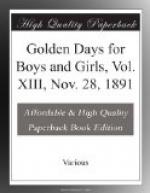This is not reconcilable with the scriptural account, which places the crucifixion at the Jewish Easter. An eclipse of the moon, however, was visible at Jerusalem on April 3, 33 A.D., so that it is most probable that the ancient historians confused the two events, and that the eclipse of the moon was the phenomenon which signalized the crucifixion.
THE VOLUNTEER WRITER.
by EFFIE ERSKINE.
“To whom are you writing, Amos?” asked his mother, as she gave a loving glance at the wasted form of the crippled boy, bent over his father’s desk.
Amos Franklin had never known what it was to be straight or strong like other boys. From infancy his legs had been crooked and his back bent, while pain and disease had shrunken his frame until, at fourteen, he looked no older than nine. But, as if to make amends, his mind was very active and his intelligence far in advance of his years.
“I will soon have finished, mother,” he answered, with a smile, “and then I will read it.”
His pen scratched away for a few minutes, and then he held up the sheet and read this:
“TO THE GIRL WITH THE BROKEN LEG:—I hope you will not fret or worry too much over your misfortune, because it will not be many days before you are out again, and in a short time be well and strong as ever. You have many happy days before you, when you can romp and run in the bright sunshine; and you must think of those days and not of the present. I will write to you again, if you say so.
“Your friend,
“AMOS FRANKLIN.”
Mrs. Franklin listened to the reading of this letter with an amazed look.
“I don’t understand it,” she said. “Who is this girl, and where did you hear about the accident?”
“I don’t know her name, or who she is,” replied Amos, with a quiet laugh. “But I know that in the three or four hundred patients in the big hospital there must be one girl with a broken leg, and they will give it to her, and it will make her feel glad.”
Mrs. Franklin looked at Amos with a smile on her face, but without speaking.
“Then I have written,” continued the little cripple, “three other letters to boys and girls in the hospital, directing them to what I think they’re most likely to be laid up with. And I mean to watch the papers hereafter for the ‘casualty cases,’ so that I can get their names. That will be so much nicer, won’t it?”
Mrs. Franklin came over and stroked his hair affectionately.
“Is this your own idea?” she asked.
“Yes,” he answered, brightly. “I got to thinking how lonesome the children must be, even if the nurses are kind; and you know folks can’t always visit them. Then I knew no one would think of writing letters, and it would be such a treat for them to know that a strange boy was talking to them.”
“My dear son,” murmured his mother, fondly.




